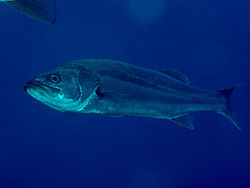| Lateolabrax | |
|---|---|
 | |
| Japanese seabass (L. japonicus) | |
| Scientific classification | |
| Kingdom: | Animalia |
| Phylum: | Chordata |
| Class: | Actinopterygii |
| Order: | Acropomatiformes |
| Family: | Lateolabracidae V. G. Springer & Raasch, 1965 [1] |
| Genus: | Lateolabrax Bleeker, 1855 [2] |
| Type species | |
| Labrax japonicus Cuvier, 1828 | |
| Synonyms | |
Lateolabrax is a genus of commercially important ray-finned fishes known as the Asian seabasses. It is the only genus in the family Lateolabracidae. [3] This genus is native to the coastal waters of the western Pacific Ocean. [4] This genus has also been included in family Moronidae (temperate basses) and may be nested within the Polyprionidae. [5]
One potential fossil genus is also known in Avitolabrax from the earliest Miocene of Japan, which may be ancestral to Lateolabrax. [6]

